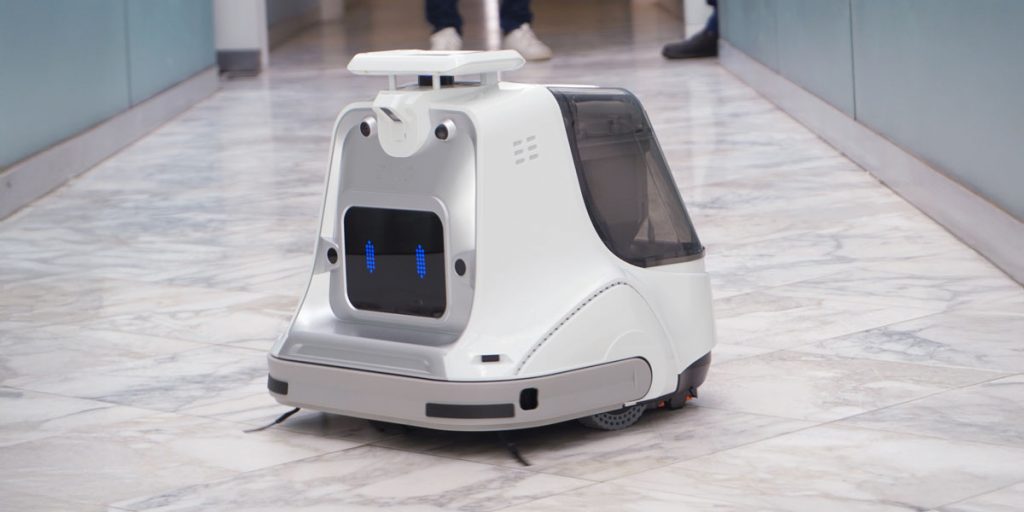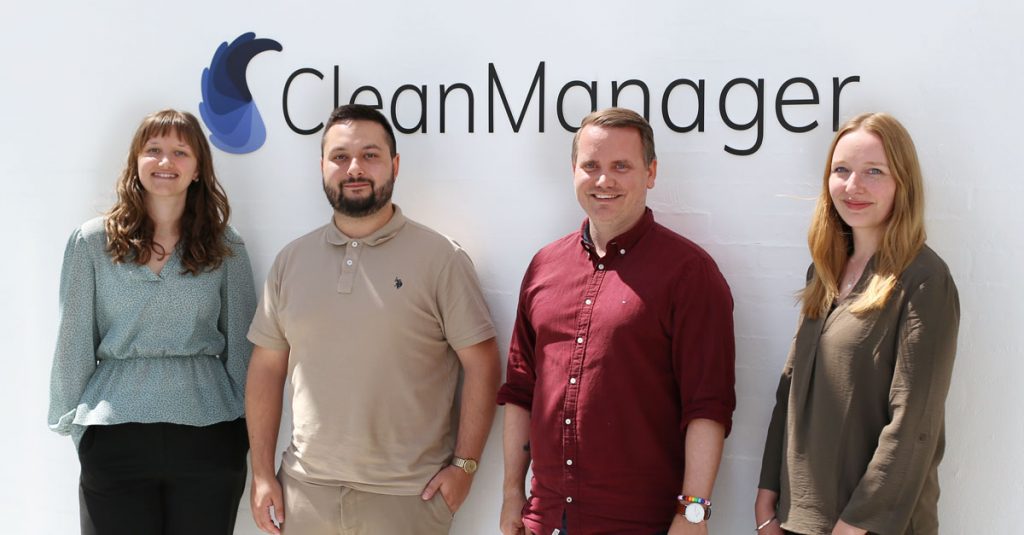Digitalisation is no longer just a buzzword — it’s a practical way to make cleaning operations smoother, smarter, and more efficient. From cleaning company software to IoT technology, there’s a wide range of tools ready to help. We’ve tested some ourselves, including IoT devices and our cleaning robot, and seen first-hand how they can transform daily work. In fact, official UK data shows that companies embracing modern technology achieve around 19% higher turnover per worker than those who don’t. Let’s explore what digitalisation really means, why it’s worth the effort, and how to make it work in the real cleaning world.
The Reality of Everyday Cleaning Management
It’s 7:00 AM, and the day has only just begun. Two cleaners have rung in from bed with the flu, the phone is buzzing with last-minute changes, and a client is already chasing proof of yesterday’s job.
These challenges often stem from manual scheduling, paper-based checklists, and reactive problem-solving, all of which create unnecessary stress and inefficiency.
But many of these issues can be solved with the right digital tools and cleaning technology. If you can spare a bit of time and effort, small steps toward digitalisation can make a big difference.
Many cleaning companies see digitalisation as a big change, and it can be. It’s easy to wonder about the cost, the learning curve, or whether it will work in daily operations. But with the right approach, these concerns don’t have to be obstacles. By focusing on the tools that truly fit cleaning companies, and introducing them step by step, you can make digitalisation a natural, valuable part of everyday work.
What Digitalisation Really Means
Digitalisation is about taking the “what ifs” out of daily work. Imagine this: a cleaner finishes a shift and uploads a photo audit instead of leaving a paper checklist in the office. The site manager instantly sees the proof, payroll hours are logged automatically, and the client gets a real-time update. That’s digitalisation in action — making the flow of information faster, more reliable, and more useful for everyone.
Here are four areas where digital tools are already reshaping how cleaning businesses plan, deliver, and document their work:
The Core Areas of Digitalisation in Cleaning
These are the four main areas where digital tools can make a measurable difference:
- Smart Planning & Time Tracking
- Digital rosters, shift assignments, and real-time updates.
- Staff clock in and out via mobile, NFC, or QR codes, so you know who’s where and when.
- Digital rosters, shift assignments, and real-time updates.
- Digital Site Files & Quality Audits
- All site-specific information, safety guidelines, and cleaning specs stored in one place.
- Audits and checklists with timestamps and photo proof to track quality and compliance.
- All site-specific information, safety guidelines, and cleaning specs stored in one place.
- Data-Driven Task Triggers
- Using IoT technology (like occupancy sensors or dispenser monitors) to create cleaning tasks based on real need instead of fixed schedules.
- Reduces wasted effort and helps prioritise work where it’s most urgent.
- Using IoT technology (like occupancy sensors or dispenser monitors) to create cleaning tasks based on real need instead of fixed schedules.
- Predictive Maintenance
- Tracking machine usage, performance, and service intervals to prevent breakdowns.
- Ensures connected cleaning machines stay safe, compliant, and available when needed.
- Tracking machine usage, performance, and service intervals to prevent breakdowns.
At CleanManager, we’ve tested these areas ourselves — from an example of IoT in cleaning with our sensors, to running a connected cleaning robot in our own office.

Digitalisation in Practice – Our Own Tests
IoT Sensors
We tested IoT sensors in our own office to explore how real-time data could guide cleaning plans and reduce unnecessary work. The sensors measured occupancy, temperature, and humidity, with data sent automatically to a browser dashboard — no Wi-Fi or complex setup required.
Discover how simple sensors cut wasted effort in our office — read the full case, What We Learned from Testing Sensor Technology in Our Office.
The Sensor’s Strengths
- Easy setup – no cables, Wi-Fi, or technical support needed.
- Clear usage insights – one meeting room was used far less than expected, allowing us to cut cleaning there and focus on busier areas.
- Better planning – visual data made it easier to discuss and adjust cleaning schedules with the team.
- Non-intrusive – no cameras or personal data collected.
Considerations
- Sensors can’t detect crumbs, spills, or mess that still requires cleaning, even if the room appears unused.
Our Little Cleaning Robot
We tested a connected cleaning robot in our own office to see if it could improve floor care without adding extra work hours.
Meet our little robot properly, read the full story, Cleaning Robots: A Real Relief or just Hype? We Tested it.
The Robot’s Strengths
- More consistent cleaning – delivered a uniform result across all areas.
- Reduced strain on staff – no need for daily manual vacuuming, freeing time for other tasks.
- Easy to integrate – worked smoothly once routes and schedules were adjusted.
Considerations
- Requires planning – doors need to be kept open and spaces cleared for the robot to navigate.
- Best in open areas – performs well in larger spaces without too many obstacles.
What Are the Digital Solutions and Tools?
Digital tools can help make cleaning work faster, easier, and better organised. Here are some of the most useful ones:
Data-Driven Cleaning
- Sensors check if rooms are used, how much soap or paper is left, or other conditions.
- Cleaning tasks are created only when needed, not just on a fixed schedule.
Benefit: Saves time and focuses staff effort where it actually matters.
Connected Cleaning Machines
- Tracks when machines are used and when they require service.
- Sends alerts before a breakdown, so you can fix it early.
Benefit: Keeps equipment running smoothly and avoids costly downtime.
Cloud-Based Systems
- Online rosters, work orders, and site files you can access anywhere.
- Cuts down on paperwork and reduces mistakes in pay or invoices.
Benefit: Reduces admin hours and keeps everyone working from the same, up-to-date plan.
Predictive Maintenance
- Uses machine data to plan repairs before problems happen.
- Helps equipment last longer and prevents expensive downtime.
Benefit: Prevents surprises and extends the life of your machines.
Digital Work Planning
- Lets you give and change tasks instantly.
- Updates schedules right away if staff are off sick or priorities change.
Benefit: Keeps schedules flexible and avoids daily firefighting.
Optimised Resource Use
- Matches staff and tools to real cleaning needs.
- Avoids overstaffing and wasted trips.
Benefit: Cuts wasted labour and travel time, improving margins.
Improved Staff Training
- Step-by-step guides, short videos, and mobile tools for quick training.
- Keeps quality and compliance high across all sites.
Benefit: New staff get up to speed faster and deliver consistent quality.
What can Digitalisation Add to Your Cleaning Business?
- Efficiency: You clean only when it’s actually needed — no wasted time on empty rooms or unused spaces.
- Quality: Effort goes where it makes the biggest difference, which lifts overall cleaning standards.
- Trust: Clients see instant proof of service, so you never scramble for documentation again.
- Staff satisfaction: Clear tasks and less repetitive work reduce stress and make jobs safer.
- Data-driven decisions: Instead of guessing, you adjust routes, timings, and staffing based on real evidence.

Ready for a Digital Journey with Our UK Team?
See how small steps can make a big difference. Explore how CleanManager’s cleaning company software for planning, time tracking, and quality tools can support your move to digitalisation.
Reach out today at +44 330 818 3119 or support@cleanmanager.uk
Q&A: How to Make Digitalisation Work for You
How do we get our staff on board?
Start small and involve them early. Explain why the tools are being introduced and how they make everyday work easier. Provide short training sessions and show practical examples so staff see the benefits quickly.
Read more on managing new implementation in our blog, From Technology Scepticism to Success with Change Management.
Do we need to be tech experts?
No. Modern cleaning software is built for everyday use, not IT specialists.
Will it replace staff?
No. Digital tools support staff by removing admin and giving them clarity, not replacing them.
What if it becomes too complicated?
Focus on tools that solve your most pressing problems first. Don’t try to digitise everything at once. Avoid data overload by setting clear goals — for example, using digital time tracking just to reduce payroll errors in the first step.
How do we avoid juggling too many systems?
Choose integrated solutions that talk to each other. A single platform for planning, time tracking, and quality control is easier to manage than three separate systems.
What about data privacy and compliance?
Always check that the tools meet local regulations, such as GDPR in the UK and EU. Look for providers who are transparent about data storage, security, and user permissions.
How much should we invest at the beginning?
Digitalisation doesn’t have to be all or nothing. Many tools are available on subscription, which means you can scale up as you grow without heavy upfront costs.
How soon can we expect results?
Some benefits, like fewer payroll mistakes or faster scheduling, can be felt right away. Others, like better planning insights from IoT sensors, emerge over weeks or months as more data is collected.



